The mid-20th century was very critical for global society. Industrialisation, science and technology had a hand in shaping modern society. Suddenly, World War II caused an abrupt realignment of political boundaries and political order. In this situation, India was liberated from Colonial Rule. Though resources were limited, aspirations were high to usher in a democratic political order to ensure every citizen had a hand in governance. In reshaping the nation, architecture was set to play a major role as a carrier of development.
In colonial times, British architects designed most of the buildings in big cities. But in post-Independence India, the major role in architecture was to be played by Indian architects even though a few foreign architects continued to work in the country. Most of the architects studied architecture in Britain whereas some preferred to do so in the US. All of them played a role in development.
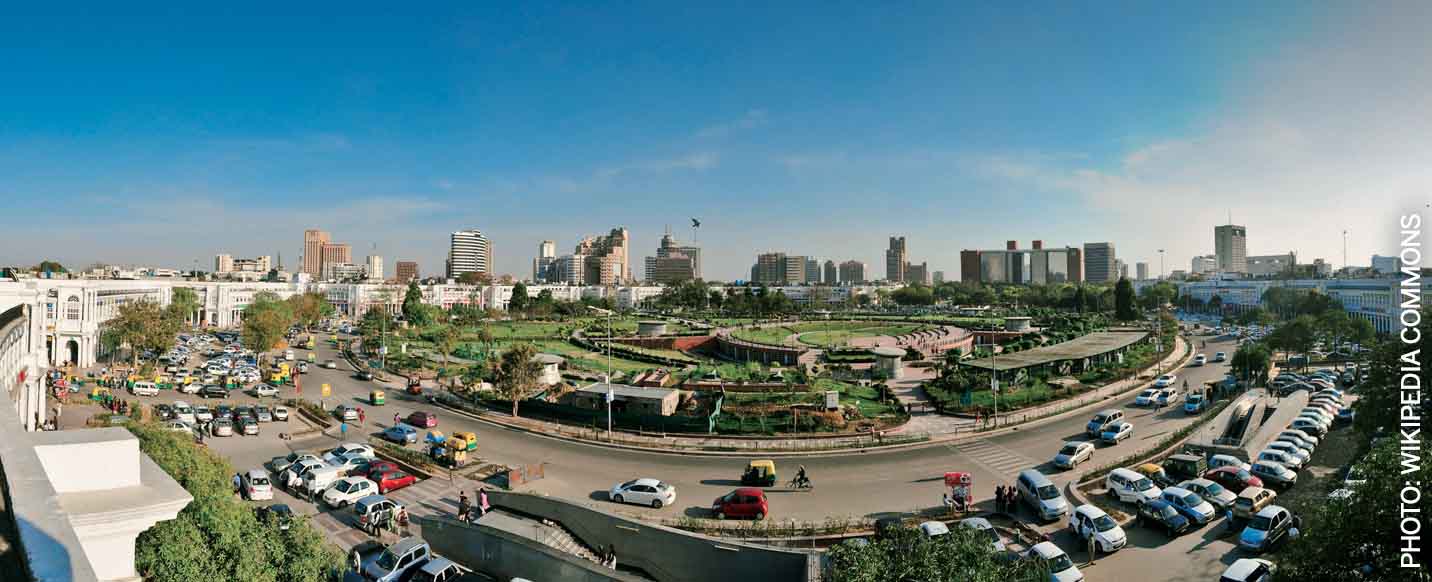
New Delhi being the capital was the most active on this front. The new Republic needed spaces to set up offices to expand the role of governance. Indra Prastha Estate was set to supplement Lutyens; a number of government buildings were erected there to house the new offices and institutions to expand the role of governance. The task was entrusted to the Central Public Works Department (CPWD). Habib Rahman – who was in Kolkata with the West Bengal PWD and had designed the Gandhi Memorial at Barakpore and the New Secretariat Building in Kolkata – was moved to the New Delhi CPWD. He designed the University Grants Commission Building (1952) at IP Estate to house the apex body to promote and regulate higher education in India.
In reshaping the nation, architecture was set to play a major role as a carrier of development
Work on this building was taken up in 1952, just after Independence when the urgency was very high to translate national aspirations into reality. At the time, reliance was on natural ventilation; so the louvers and chajjas became the preferred choice to cut unwanted direct sunlight and heat while allowing in natural light. The louvers and chajjas, which came in as climate control devices, turned into tools of a new architectural vocabulary. The interesting graphics formed by louvers and chajjas became a signature of the time.
One after the other, buildings continued to come up to house new government establishments. CAG, AGCR, Indra Prasth Bhavan, WHO (1962) and many more came up in IP Estate. In those days when e-communication and e-banking services were not available, the Post and Telegraphs services were of the utmost importance, and so the Dak Tar Bhavan (1955) and Sardar Patel Bhavan came up very close to Parliament House. Both building were designed by Habib Rahman.
Meanwhile, Josef Allen Stein, who was with the Bengal Engineering College, Shibpur, also shifted to Delhi to start private practice. Even though in the first decade after Independence the CPWD played a major role, by the year 1960 – besides the government building by CPWD – a number of private architecture firms had started marking the skyline of Delhi.

The urgency for creating office spaces eased a bit and the quest for cultural identity was on the priority list of the government. The Mandi House area close to IP Estate turned into a cultural hub, where Habib Rahman created Rabindra Bhavan to house the Lalit Kala, Sangeet Natak and Sahitya Academies, and Joseph Allen Stein designed Triveni Kala Sangam (1957). Later, Shriram Centre for Performing Arts (1972), designed by Shiva Nand Prasad, came up there.
The year 1970 was another turning point, when the nation started real development. Architectural expressions were used to express aspirations for development, Vikas Minar at IP Estate and Hindustan Times House at Kasturba Gandhi Road started to mark the skyline of Delhi. Architect Raj Rewal came up with the Hall of Nations (1972) at Pragati Maidan, which was designated as a large exhibition ground to showcase the progress the country was making.
In 1980, India Habitat Centre, designed by J.A. Stein, came up at Lodhi Road, where Stein had already designed India International Centre (1962), Ford Foundation Headquarters (1968), UNESCO and the World Wildlife Fund buildings as well as the re-layed Lodhi Garden. J.A. Stein had also rendered many industrial buildings in and around Delhi giving new vocabulary in architecture for industry.
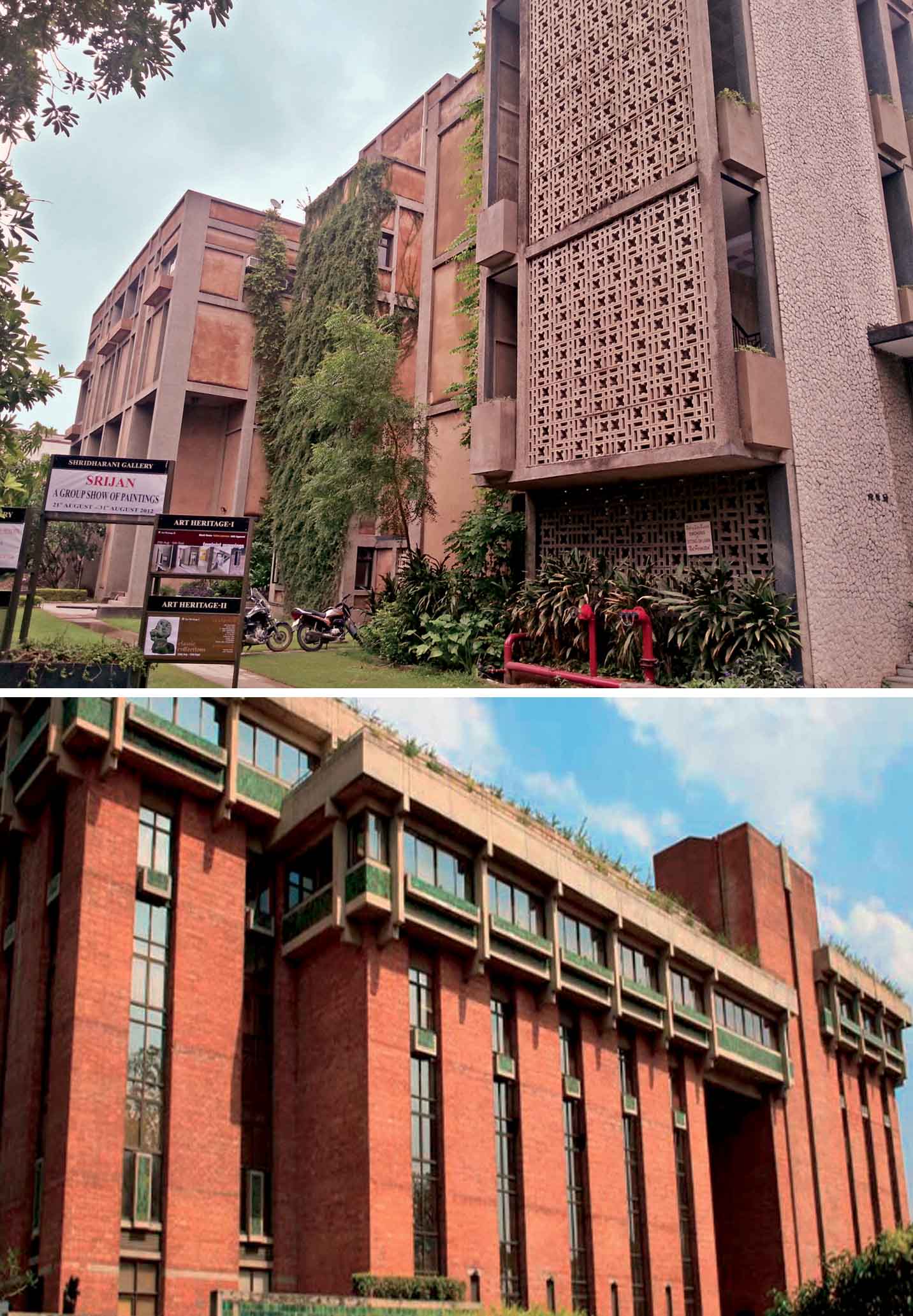
Bottom: The Habitat Centre
The Headquarters of the New Delhi Municipal Corporation (NDMC) is the signature design of architect Kuldip Singh and has been a source of inspiration for society in many ways. The expression of the building profile was so strong that it was taken as the insignia of the NDMC.
In 1986, the Mumbai-based architect Charles Correa put his signature on the Delhi horizon with the LIC Building, where glass curtain façades and open steel space frames with red sandstone marked a new approach in architectural expression. Close by he also worked on the British Council Library (1992).
Achyut Kanvinde has also left a very strong mark in post-1960 architecture. His work spread to many cities like Ahmedabad, Lucknow and Kanpur and he has made a significant contribution where institutional buildings are concerned, especially the laboratories of the Council of Scientific and Industrial Research. In Delhi as well, he designed a number of projects like the Indian Council for Cultural Relations (1961), the National Dairy Development Board (1982) and the National Science Centre (1992).
Raj Rewal designed the Parliament Library, which is an example of construction in continuum, that was an add-on to Parliament after a gap of over half a century. The addition respects the parent building while conforming with its lineage.
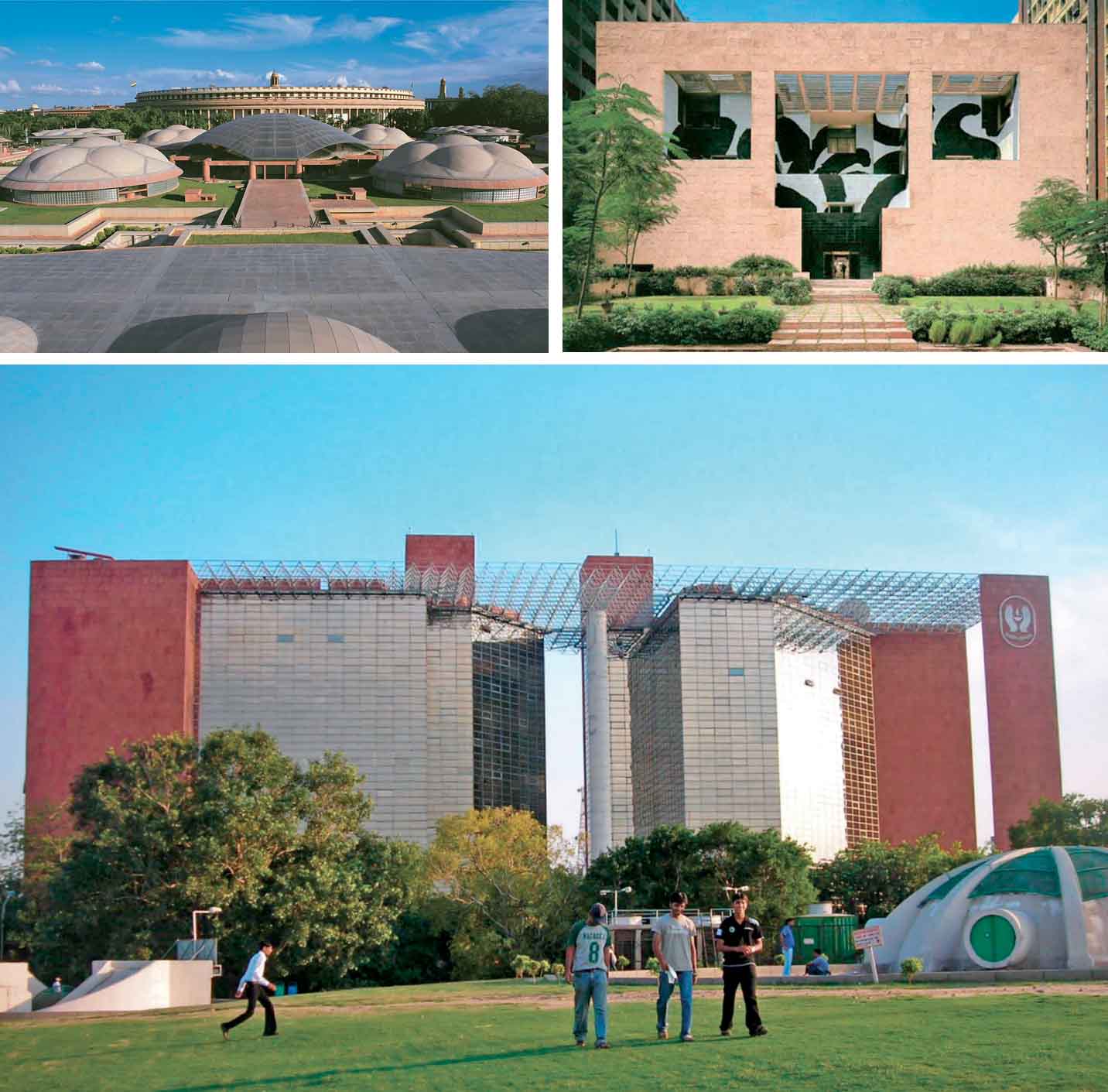
Right: British Council
Bottom: The LIC building
While Otto H. Koenigsberger was planning Bhubaneswar as the capital for Odisha, Le Corbusier was designing the capital for Punjab very close to Delhi. Though the presence of buildings by Le Corbusier may not be significant in Delhi, his strong influence in North Indian post-Independence architecture is unmistakeable. He convinced the architects of that period that RCC is the most versatile of materials for architectural expression. Louis Kahn, who was in Ahmedabad in the 1960s, made poetry with bricks leaving a legacy for expression in exposed brick. The obsession with RCC dominated for decades; experimentation and expression in steel and other materials was stagnant. In the Partiment Library the infusion of steel set the new direction for contemporary architectural expression.
Nowadays, extensive expression in steel, glass and granite can be seen. The refurbishing of the Jawaharlal Nehru Stadium to host the Commonwealth Games 2010, which had originally been constructed in RCC to host the Asian Games 1982, has been re-enveloped with steel. Similarly, the Indira Gandhi Airport, which was built in RCC for the Asian Games in 1982, was replaced with new steel terminals at the time of the Commonwealth Games in 2010. Now the extensive work on the Delhi Metro Stations as well as corporate offices is being planned extensively in steel and glass.

Bottom Left: Civic Centre
Bottom Right: Jaypee Greens, Noida
After getting over the urgency for creating office spaces, the scope of architectural priorities expanded and housing got the attention of the government. In 1954, an exhibition and design competition for housing was organised by Habib Rahman who has a reputation for designing large-scale high-rise office buildings. The designs for low-rise dwellings for junior staff received a lot of acceptance, with virtually all his designs being adopted for government housing by the CPWD all over the country. In Delhi these were built at RK Puram, where they are still known as Rahman-type flats. There he also designed high-rise flats with staggered balconies, which were repeated at Shahjahan Road’s government housing as well. Curzon Road Housing, External Affairs Hostel (presently K B Marg) were all designed by him.
Nowadays, extensive expression in steel, glass and granite can be seen
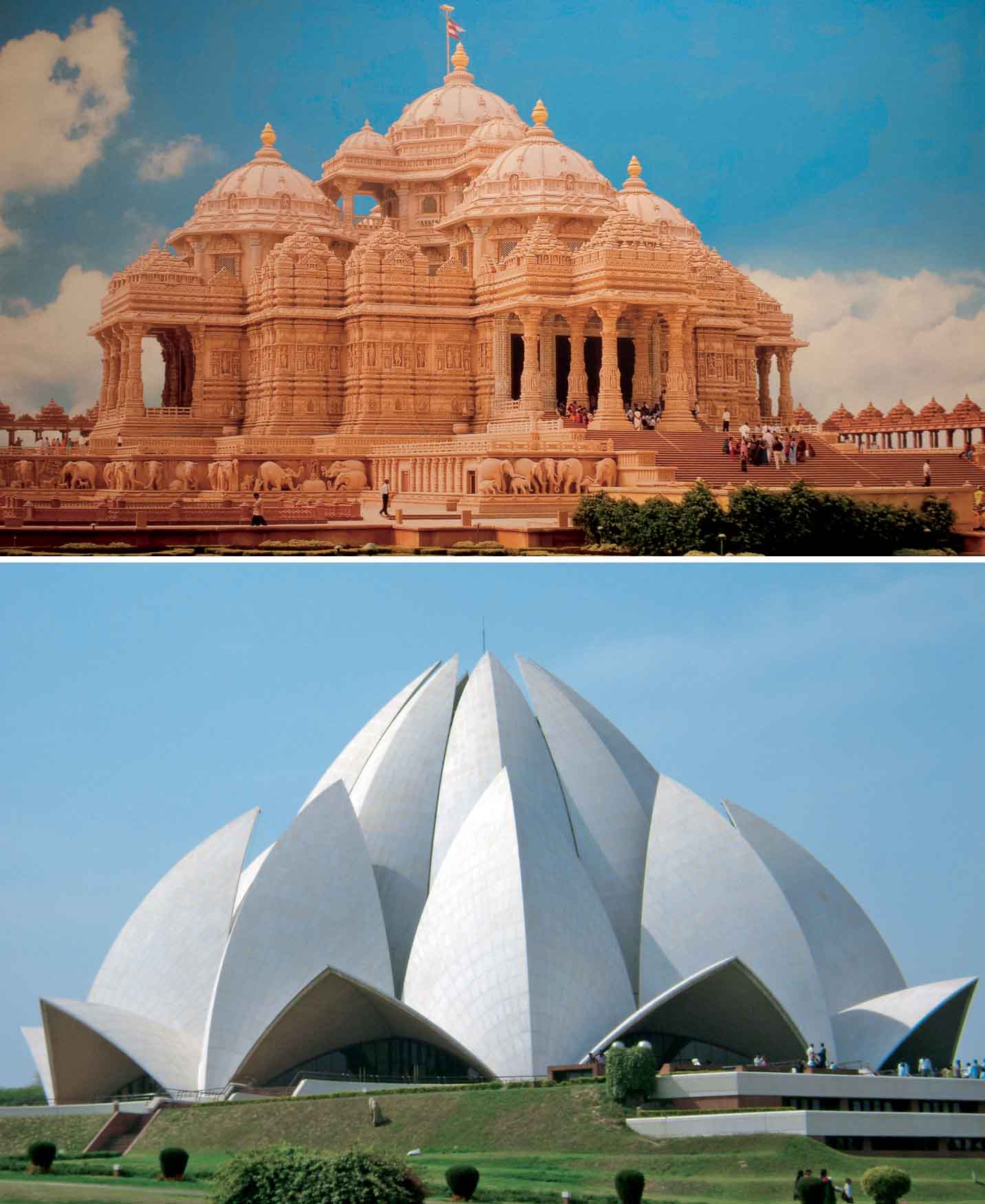
Bottom: Lotus Temple
From 1970 onwards there was a lot of activity in housing projects in Delhi. Yamuna Apartments (1975) by Design Group, Malviya Nagar Housing (1976) by Kuldip Singh, Tara Housing (1978) by Charles Correa, Press Enclave Housing (1979) by Ashish Ganju, Sheikh Sarai Housing (1982) and Asian Games Village (1982) by Raj Rewal were the lead projects in redefining the housing typology of Delhi.
Delhi being a traditional city with a wide diversity and multi-religious identities and cultural traditions has continued with the expression of religious icons in continuity with traditions in transformation of its architectural expression. The Syrian Orthodox Church (1962) by Design Group and Lotus Temple by architect Fariborz Sabha are icons of Delhi in the 21st century. As are the Kali Bari by Sumit Ghosh, the ISKON Temple by Achyut Kanvinde, the Buddha Memorial by Ashish Ganju, the India Islamic Cultural Centre and the Akshardham Temple. The legacy of religious icons in the architectural fabric of Delhi continued in post-Independence India.
The core area of Delhi has almost reached a saturation point and consequently the neighbouring cities like Noida and Gurgaon have become hyperactive hubs of the 21st century architectural experimentation. A few more buildings have come up in Delhi, which have left their mark like the Civic Centre and the head office of Delhi Municipal Corporation by architect Shirish Malpani.
The new skyline of Delhi is being defined by the skyline of NCR (National Capital Region) where the boundaries of Noida, Greater Noida, Gurgaon and Faridabad have merged with Delhi to form a giant urban agglomeration.
All photos: Wikipedia Commons

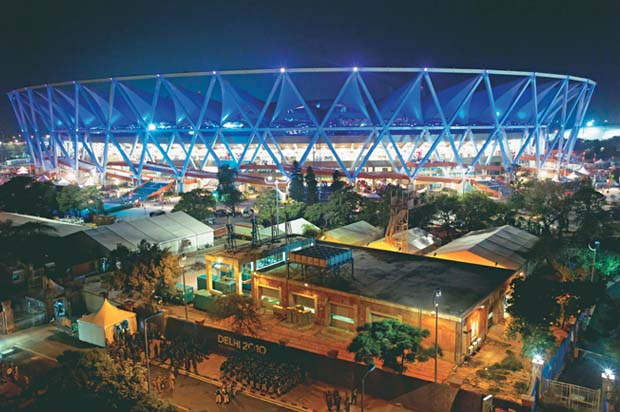

Comments (0)